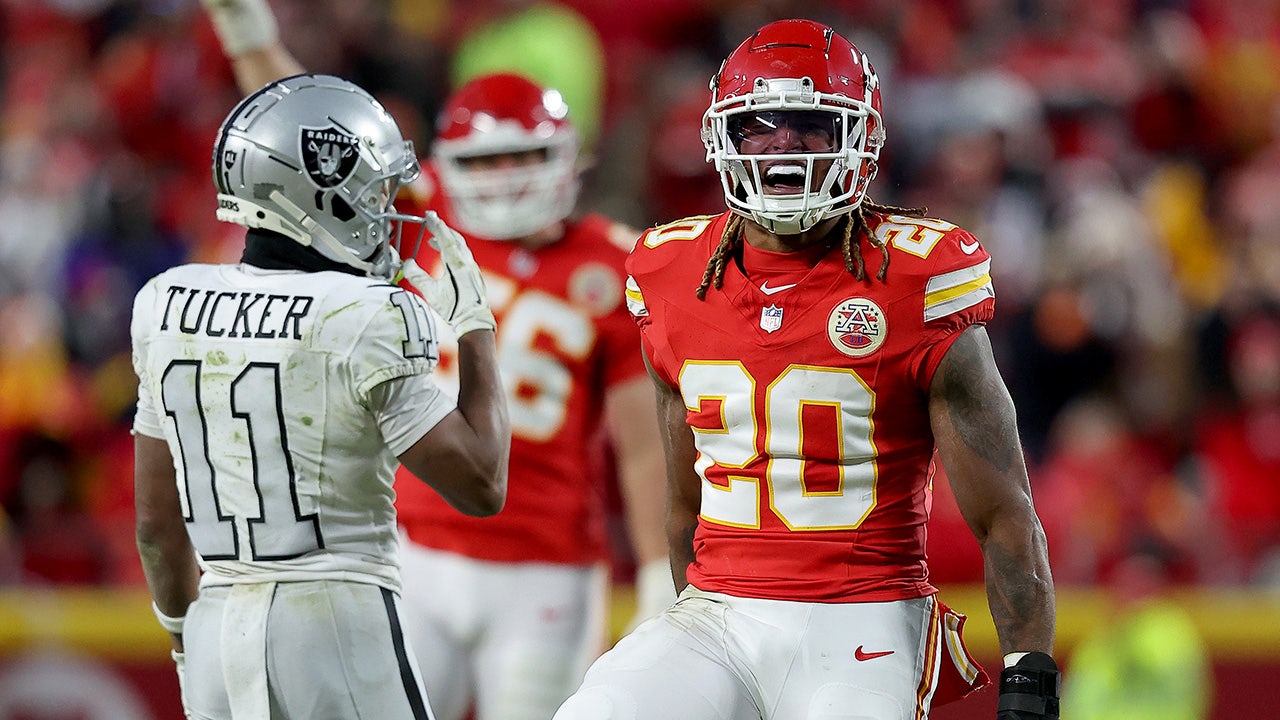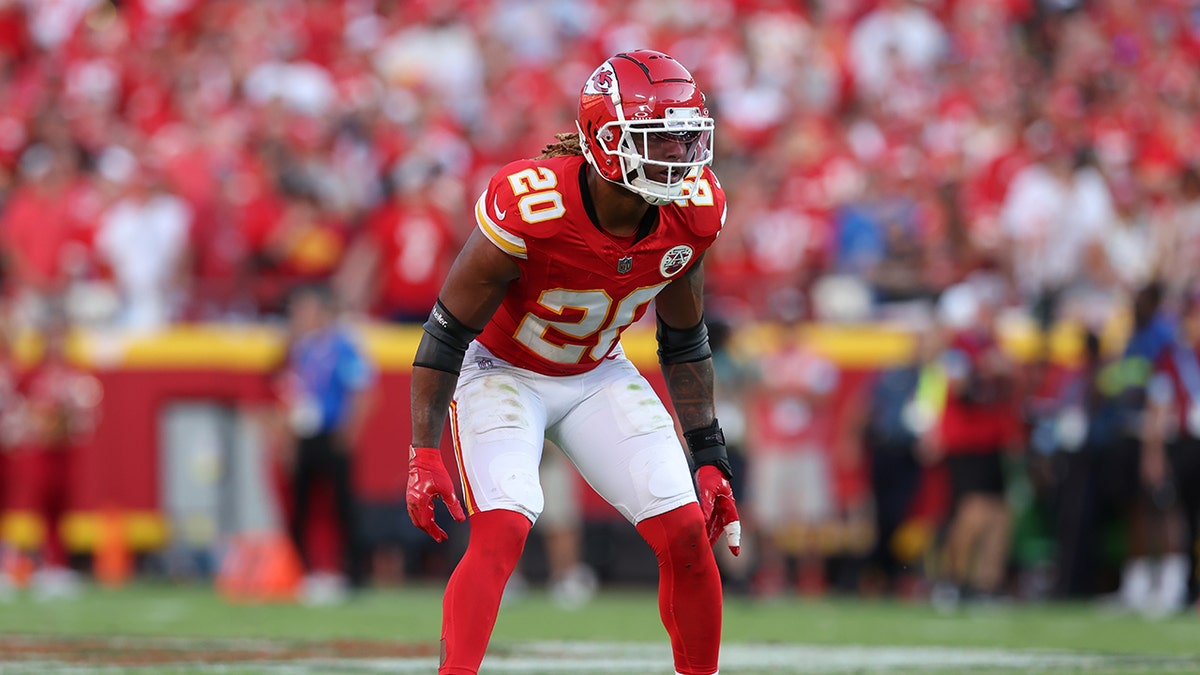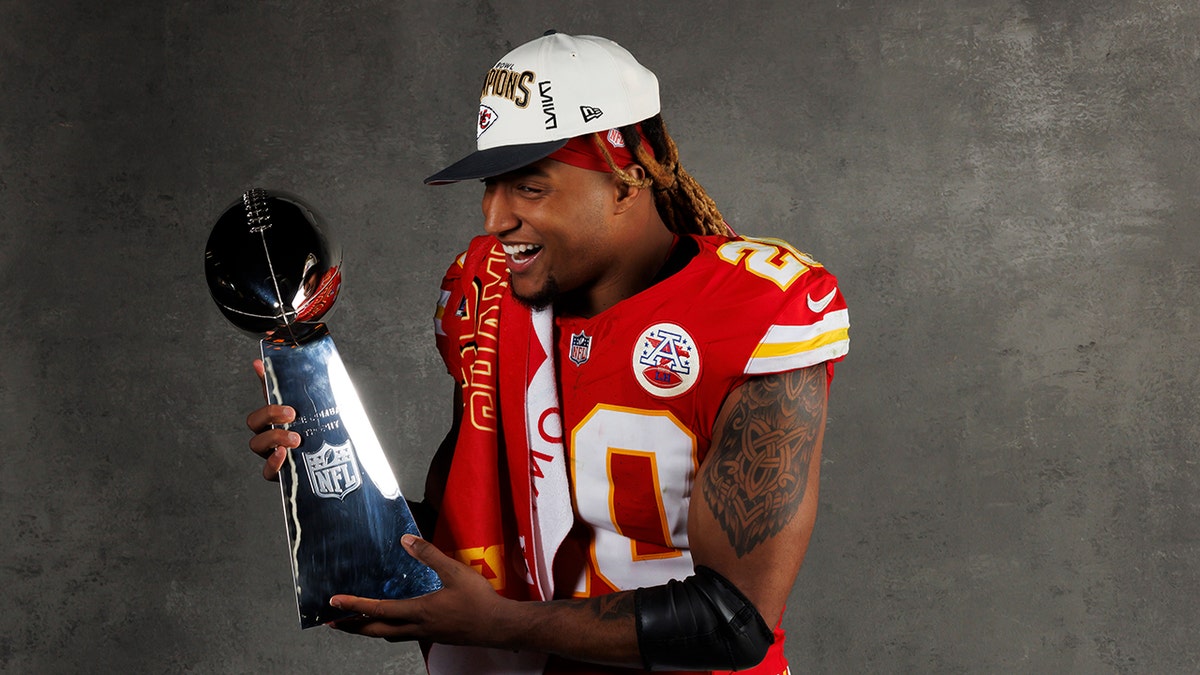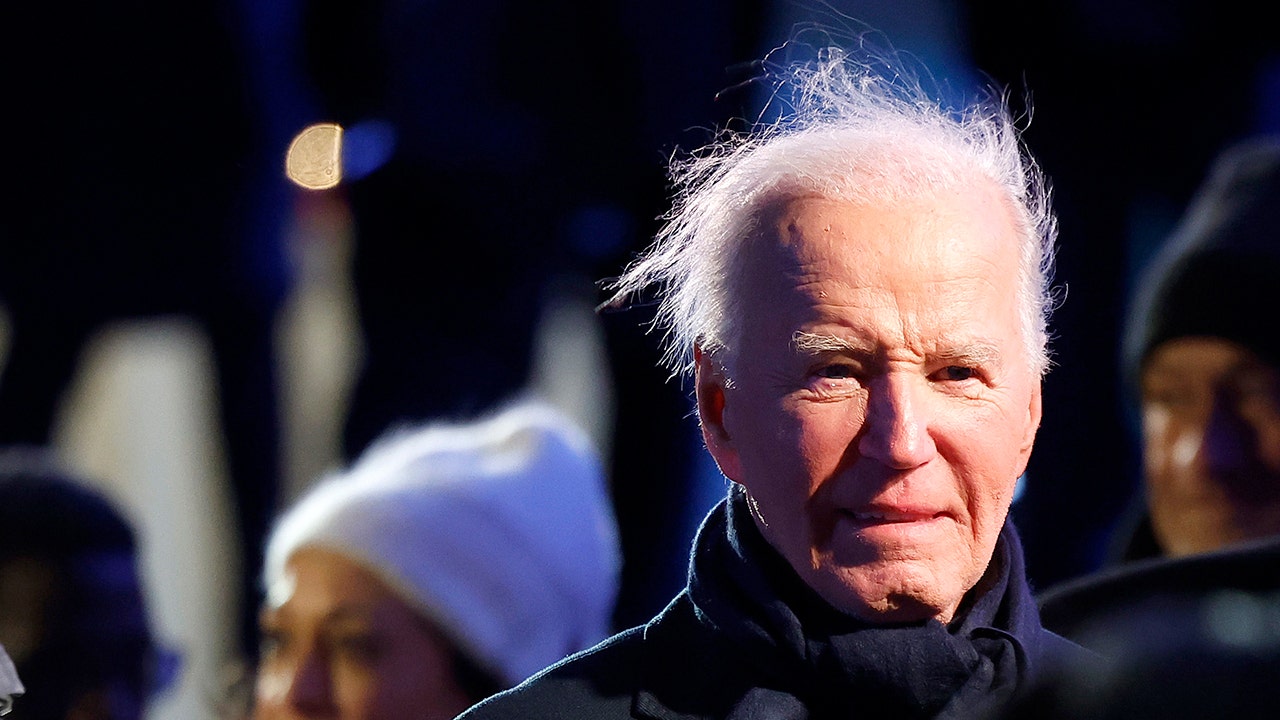Sports
Woody Marks finally getting the chance to unleash his total skill set at USC

As Woody Marks weighed his football future last winter, Darren Myles was frank with his former running back. His body of work, he told Marks, was an incomplete picture of the player Myles knew he could be. Four seasons at Mississippi State, playing in Mike Leach’s pass-happy Air Raid offense, proved Marks could catch passes out of the backfield. But he was typecast in the eyes of NFL scouts as a third-down, change-of-pace player, incapable of carrying the load as a bruising back running between the tackles.
His high school coach knew better than that. Myles had seen it during four years at Carver High in Atlanta. He watched as Marks stepped in as the starter before his first game as a freshman, taking the place of a senior who missed practice and never relinquishing the role.
During 43 games at Carver, Marks carried the offense on his back, toting the ball 614 times for 10 yards per carry. As a sophomore, he tallied 13 consecutive 100-yard games. As a senior, he scored 23 touchdowns. Never did he catch more than a pass or two per game.
So the notion that Marks was pigeonholed as a pass catcher or seen as anything less than a three-down workhorse didn’t sit well with Myles. His advice? Find an offense where you could prove who you are.
Marks seems to have found that and then some at USC, where he’s already established himself as one of the Big Ten’s most complete backs. Through five games, Marks has carried the ball 81 times, sixth most of any running back in the conference. At his current pace — more than 16 per game — he’s likely to break his career high in carries before the end of October.
That hasn’t precluded him from being a pass catcher, either. Marks is third on the team in catches with 19, just two fewer than the Trojans’ top two receivers.
“He’s been exactly what we’d hoped he’d be at this point,” coach Lincoln Riley said.
That feeling, his mother says, is mutual.
“He looks just like he did in high school,” Tameka Marks said. “He’s showcasing it again, what he didn’t get to showcase the last four years at Mississippi State — that he can actually run!”
USC running back Woody Marks runs through Utah State safety Jordan Vincent to score a touchdown at the Coliseum on Sept. 7.
(Allen J. Schaben / Los Angeles Times)
Myles knew that to be true before Marks made it to high school. He was only 13 years old, still in the eighth grade, and weighed barely 155 pounds, but Myles, a former running back himself, could see Marks was a natural. He had the vision, the quickness, the instincts. Most of all, he was fearless. Even at his size, there wasn’t a tentative bone in his body.
After four practices, Myles approached Tameka to tell her Woody probably would factor into the varsity roster as a freshman. By the first week of football season the following fall, Marks already was the focal point of Carver’s offense. The promotion had come after the senior incumbent missed a mandatory practice during fall break. Marks ran for 145 yards and two touchdowns in his stead.
“Right away, I moved that kid to slot receiver,” Myles said. “Like, you’re gonna back up Woody Marks now.”
Marks averaged 12 yards per carry as a freshman, yet was limited to fewer than 10 carries per game as Myles spread the ball around in Carver’s offense. But by the end of that season, Myles said, Marks had mastered the zone-run concepts at the heart of his offense, and as a sophomore, he exploded for 2,127 yards in 13 games.

USC running back Woody Marks celebrates after scoring the winning touchdown against LSU on Sept. 1.
(Robert Gauthier / Los Angeles Times)
By then, Myles knew he could lean on Marks, if needed. He rarely received more than 20 carries in a game, but in consecutive playoff wins over Jones High and Flowery Branch, Marks put the offense on his back, tallying more than 200 yards rushing.
“Once he got past the linebacker, it was over,” Myles said. “You talk about having a running back with wide receiver speed. Once he gets to the second level, he’s gone. You’re not catching him.”
Offers rolled in from across the country — everywhere, it seemed, but Georgia, the local college football power, whose staff had asked Myles if Marks would consider changing to slot receiver.
“It bothered him,” Myles said. “But it motivated him to work even harder.”
And with more work, Myles trusted Marks even more to carry them.
During one game, as a senior, Carver lost its quarterback to a hip-pointer injury. With only an inexperienced freshman left at the position, Myles pivoted to run the entire offense through Marks.
For the second half, nearly every play went through the running back, who even lined up for some direct snaps as a wildcat quarterback. By then, the defense knew what was coming most plays. Inside zone. Outside zone. Inside zone. And on and on.
“They were stacking the box,” Myles said. “It didn’t matter.”

USC running back Woody Marks drags LSU safety Dashawn Spears into the end zone for a touchdown on Sept. 1.
(Robert Gauthier / Los Angeles Times)
Marks committed to Mississippi State about eight months before the coach he committed to, Joe Moorhead, was fired. Into his place stepped Leach, whose reputation for largely ignoring the run preceded him. The family weighed whether Marks would be better suited elsewhere. But he’d already made his pledge. He stuck with it.
And over four years at Mississippi State, three of which were under Leach, Marks never rushed for more than 582 yards in a season. In 45 games, he received more than a dozen carries just eight times and only twice ran for more than 100 yards.
Losing Leach, who died suddenly in late 2022, only muddied Marks’ role. He considered transferring but ultimately chose to stay in Starkville. Then a hamstring injury late in the 2023 season sapped Marks of his usual burst.
If not for the injury, he might’ve declared for the draft right then, his mother said. Prospective agents told them he’d be picked in the middle rounds, perhaps as high as the third. But they wondered if another year, in the right offense, might alter that trajectory.
Several schools had the same thought, among them Georgia, which apparently had gotten over its hang-ups about Marks’ size. But the fit with Riley, an Air Raid protege of Leach, felt seamless. Marks already was familiar with most of the offense’s zone-run concepts.
“He’s been doing those things since he was 13 years old,” Myles said.
It’s no wonder then that his impact at USC has been so instantaneous. Marks already has more 100-yard games (three) at USC than he did in all of his time at Mississippi State. And as defenses have tried to take away dynamic plays downfield, he’s been called upon even more, having touched the ball 47 times over the last two games.
“Everything [Riley] told us about how he would use him,” Tameka said, “we’re seeing it every game.”
Marks’ role actually could stand to grow from here, with Big Ten defenses daring Riley to run, sure to follow a similar blueprint to what worked for Minnesota last Saturday. Marks was on his way to a career day until the final 11 minutes, when he didn’t touch the ball a single time.
Nonetheless, there’s no doubt at USC that it has a three-down back at its disposal, one capable of grinding away Big Ten games in a way it desperately will need down the stretch.
Though, Marks isn’t sure he’s lived up to that just billing yet.
“I really think I haven’t proven a lot,” Marks said. “We hold ourselves to a higher standard. We’re going to get to that.”

Sports
Chiefs are motivated by doubters who say record is a fluke, star says: 'We'll just keep showing up'

It’s been rather commonplace to say that the 13-1 Kansas City Chiefs should not be what their record is – but that’s just fuel to the fire for the back-to-back champions.
Sure, the Chiefs have won multiple games on their last possession, and the ball has bounced their way plenty of times – literally and figuratively.
But Chiefs safety Justin Reid, quite literally, is thanking those who doubt what the Chiefs can do in the playoffs.
Justin Reid #20 of the Kansas City Chiefs celebrates a defensive stop against the Las Vegas Raiders during the fourth quarter in the game at GEHA Field at Arrowhead Stadium on November 29, 2024 in Kansas City, Missouri. (David Eulitt/Getty Images)
“Thanks for the motivation. We appreciate the motivation that people give us,” Reid told Fox News Digital in a recent interview. “Despite winning two championships in a row, despite everything that they said last year, they still don’t believe. And we appreciate it. That fires us up when we hear it. I like the extra motivation. It gets me fired up, and it gets me to go out there to prove a point.
“They don’t ever have to [learn]. We’ll just keep showing up.”
Reid has won two Super Bowls with the Chiefs, but his ring back in February wasn’t the only championship he won this year. He also took home Chess.com’s BlitzChamps title.
Reid was always intrigued with chess but took it more seriously when he got into the NFL – and now, it’s become somewhat of a staple in the locker room.
“We have a tradition where we play every night before the game. Right when we finish team meetings, I have a chess board sitting at my locker, guys come, and we play quick five-minute games. Guys from the front office come down, players play, and if you win, you stay, you lose, you get back in line,” Reid said.

Kansas City Chiefs safety Justin Reid (20) in the fourth quarter of an NFL game between the Cincinnati Bengals and Kansas City Chiefs on September 15, 2024 at GEHA Field at Arrowhead Stadium in Kansas City, MO. (Scott Winters/Icon Sportswire via Getty Images)
‘JEOPARDY!’ CONTESTANTS BEFUDDLED BY FINAL CLUE RIPPING JETS’ SUPER BOWL DROUGHT
The safety added it’s become a combination of both superstition and firing up the brain before a game.
“You can’t always be too deep in anything. It’s nice to get your mind off one subject and do something else. I think it’s fun for that and it has become a bit of a tradition that we just always do that now,” he says.
NFL Films will be releasing a documentary about Reid’s chess title and how other NFL stars have gotten involved. The title also gave Reid the ability to raise money for his own charity.
“Everyone uses the same ‘it’s a game of chess’ whether it’s football or business or whatever’s going on,” Reid said, adding it’s a good way for people to connect. “It’s a way of using tactics and being three steps ahead of your opponent. It’s fun they’re promoting it. I think that it’s good, and I think it’s a fun game for anyone to play.”
Reid faces his former Houston Texans on Saturday afternoon as the Chiefs are in the final homestretch. And considering he’s a back-to-back reigning champ, he knows exactly what it takes to bring home another Lombardi Trophy.

Justin Reid #20 of the Kansas City Chiefs poses for a portrait with the Vince Lombardi Trophy after Super Bowl LVIII against the San Francisco 49ers at Allegiant Stadium on February 11, 2024 in Las Vegas, Nevada. (Ryan Kang/Getty Images)
“You want to be playing your best football going into the playoffs, and we don’t feel like we’ve played our best football yes, which is great,” said Reid. “There’s still ways to build, still things to do to keep getting better. It’s just about not being satisfied and the preparation each week. The physical side will take care of itself, but whoever’s mentally prepared and doesn’t make those mental mistakes when the pressure’s on is going to be the difference. We’ve been here before, we’ll just keep continuing to do it.”
Follow Fox News Digital’s sports coverage on X, and subscribe to the Fox News Sports Huddle newsletter.
Sports
Prep basketball roundup: Sherman Oaks Notre Dame reaches Tarkanian Classic championship game

Sherman Oaks Notre Dame is loving late-night basketball in Las Vegas.
The unbeaten Knights (12-0) advanced to the Platinum Division championship game of the Tarkanian Classic, opening a 20-point lead before prevailing over Layton Christian (Utah) 73-60 on Friday night. Notre Dame will face Eastvale Roosevelt (10-1) for the championship Saturday at 4:30 p.m. at Bishop Gorman. They are ranked No. 2 and No. 4 in The Times’ top 25 rankings.
Tyran Stokes continued his impressive play with a 29-point, 10-rebound performance after a 30-point effort on Thursday. NaVorro Bowman had 20 points.
Eastvale Roosevelt 78, Redondo Union 74: Brayden Burries and Myles Walker each scored 18 points in the win. Roosevelt had a 45-32 halftime lead before handing Redondo Union (9-1) its first defeat. Hudson Mayes had 22 points and Chris Sanders scored 20 points for Redondo Union.
Crespi 76, St. Anthony 56: The Celts (8-4) picked up a quality nonleague win, with Peyton White scoring 26 points, Isaiah Barnes 16, Carter Barnes 14 and Malakai Perrantes 13.
La Habra 70, Sonora 45: The Highlanders are 13-1 after a strong performance from Jaedon Anderson, who made a school-record nine threes en route to a 32-point effort.
Anaheim Canyon 91, Costa Mesa 41: Brandon Benjamin had 31 points for Canyon.
Grant 67, Viewpoint 66: In only its second game of the season, the Lancers (2-0) served notice they figure to reach the City Section Open Division playoffs. Aeneas Grullon scored 26 points for Viewpoint (9-3). Wizdom Burnes, who scored 18 points and had 13 rebounds for Grant, made a shot at the buzzer for the win. Champ Merrill led Grant with 24 points.
Harvard-Westlake 74, Fairfax 33: Joe Sterling had 21 points and Cole Holden 14 points for the Wolverines.
Chatsworth 66, West Albany (Ore.) 56: The Chancellors improved to 7-1 in Oregon. Alijah Arenas had 24 points.
Golden Valley 60, Gardena 45: Alex Villego had 25 points for Golden Valley.
Legacy Christian 78, Crescenta Valley 71: Vaughn Zargarian had 41 points for Crescenta Valley.
Heritage Christian 81, Valencia 40: Tae Simmons had 22 points and Dillan Shaw 19 for 11-0 Heritage Christian.
Palisades 55, El Camino Real 54: Jack Levey made a shot at the buzzer to give Palisades the victory.
Girls basketball
Ontario Christian 73, Maryland Bullis 65: Kaleena Smith had 26 points and nine assists for unbeaten Ontario Christian (14-0), which will play in the Nike TOC final against Archbishop Mitty from San José in a game that will decide No. 1 in California and maybe No. 1 in the nation in girls basketball. Archbishop Mitty defeated Mater Dei 59-42 in the other semifinal.
Sierra Canyon 69, Coeur d’Alene (Idaho) 56: Jerzy Robinson led the unbeaten Trailblazers with 30 points.
Birmingham 65, Mt. Diablo 50: Lili Martinez had 20 points and Zoee Mitchell 16 for the Patriots.
St. Joseph 85, Valencia 84: Freshman Kamilia Basyrova scored a school-record 40 points for Valencia.
Sports
Introducing the most dangerous pass in football

A sharp, anxious intake of breath, followed by a round of applause that carries a mixture of quiet admiration and, more than anything, relief. On other occasions, it ends with supporters shaking their heads and asking why.
We are talking about the crowd reaction to — and I’m borrowing this description from a colleague who is a regular at Stamford Bridge — “the most dangerous pass in football”.
It’s the short, vertical ball from the goalkeeper to — typically, but not always — the midfield pivot, who is receiving under pressure, back to goal and close to their own penalty area.
Exhibit A: Chelsea’s Robert Sanchez trying, and failing, to pass to Moises Caicedo against Brighton earlier this season, when Carlos Baleba scored.
What a season Carlos is having! 🔥 pic.twitter.com/D7qC37kvwb
— Brighton & Hove Albion (@OfficialBHAFC) September 29, 2024
It was a case of role reversal for Baleba against Fulham when Alex Iwobi profited from a stray pass from the Brighton goalkeeper Bart Verbruggen.
Forcing the error. 👊 pic.twitter.com/g0Jmd2O2LN
— Fulham Football Club (@FulhamFC) December 6, 2024
As for Chelsea, they got their own back at Southampton, where Noni Madueke read Joe Lumley’s pass (35 seconds onwards in the clip below) to Kyle Walker-Peters and set up Christopher Nkunku for their second goal.
Tune into all of Wednesday night’s action. 📺#CFC | #SOUCHE pic.twitter.com/zY3em5RMBA
— Chelsea FC (@ChelseaFC) December 5, 2024
Fulham? It’s a minor miracle they didn’t concede against Newcastle when Bernd Leno signposted a pass to Emile Smith Rowe and Newcastle’s players were left shaking their heads in disbelief after Fabian Schar somehow failed to score.
Brentford had a reprieve against Ipswich, who were perilously close to serving a goal up on a plate to West Ham in October. A VAR offside call rescued Tottenham Hotspur’s Fraser Forster at Bournemouth, whose goalkeeper, Kepa Arrizabalaga, was lucky that Gabriel Martinelli didn’t punish him for a loose straight ball against Arsenal, which is where Mads Hermansen passed Leicester and Harry Winks into trouble (see below) in September.

As for Manchester United, the awful goal they conceded against Viktoria Plzen in the Europa League last week was yet another example.
The list goes on and on and, in many ways, provides fuel for those who wonder why so many teams continue to take such chances playing out from the back and in particular by using this type of pass.
There are probably a few ways to answer that question. The first thing to say is that, on a broader level, the coaches that play this way believe it makes far more sense to attack in a controlled way, in possession, through a mix of established principles and rehearsed movement patterns, even if that leads to the odd mistake, rather than tossing a coin and hoping it lands heads up — which is how they view knocking longer balls forward.
The second point — and this shines through when you discuss some of the incidents highlighted above with coaches who are proponents of this style of play – is that the execution of that bounce pass close to goal, taking in the decision-making around it, the positioning, and the movement and the timing, is the problem when it goes wrong, not the pass itself.
Third, it’s inevitable that the moments when it breaks down will get far more attention than the good passages of play.
Before we look at some more examples, it’s worth pointing out that some Premier League clubs — or maybe that should be ‘some Premier League managers and goalkeepers’ — have little or no inclination to play this game of risk and reward. The goalkeepers at Bournemouth (Arrizabalaga went off-piste against Arsenal), Crystal Palace, Everton, Newcastle United and Nottingham Forest in particular tend to play short sideways passes in build-up or go long.
In fact, even when the No 6 drops deep to receive a vertical ball in space with no sign of any pressure, the pass is often turned down by their goalkeepers. Below is Nottingham Forest’s Danilo, arms outstretched, asking for a ball he was never going to receive from the goalkeeper, Matz Sels.

Newcastle’s Nick Pope does the same (Bruno Guimaraes is pointing out that Sandro Tonali is free below)…

… as does Everton’s Jordan Pickford.

That said, Pickford bizarrely deviated from the script at Arsenal on Saturday. What followed was a car-crash moment between him and James Tarkowski, as the Everton goalkeeper bobbled a pass that the centre-back struggled to control, encouraging Martinelli to press. The expressions on the faces of the two Everton players afterwards said it all.

Time to look at some passages of play that show the reward and not just the risk, beginning with Arsenal’s 1-1 draw at Chelsea in November.
Declan Rice is the player to watch here. He takes up a starting position behind Nicolas Jackson, on the opposite side to the free man (William Saliba) he wants to find after Arsenal have provoked Chelsea’s press with a short goal kick.

Cole Palmer makes the standard run (curved) for any player leading the press in this situation, attempting to force the ball one way. Jackson, meanwhile, is ready to jump to Gabriel if David Raya returns the pass.

Timing and understanding are absolutely key to what happens next. Rice waits until Palmer gets closer to Raya and then runs on the blind side of Jackson to receive a soft pass in front of him that…

… he can play first time to Saliba, and Arsenal are out.

It is a pattern you will see again and again at Arsenal and elsewhere.
Below is an example of Ryan Gravenberch doing the same thing for Liverpool on the opening day at Ipswich.

Gravenberch is an interesting player to watch when receiving straight passes because of his exceptional ability to take the ball under pressure on the half-turn. In the image below, Chelsea’s Romeo Lavia is pressing him.

But Caoimhin Kelleher’s pass is ‘safe side’ (away from where Lavia is approaching), and Gravenberch is a master of getting his body between the opponent and the ball to protect and turn in one motion.

Not only are Arsenal and Liverpool retaining possession in these images, but they’re also taking opposition players out of the game while building an attack.
Take a look at this example of Manchester City playing out against Liverpool at Anfield at the start of December. The image that starts this phase of play is remarkable and, in many ways, captures the modern game: Ruben Dias is playing one-versus-one against Luis Diaz, 10 yards out, with nobody in goal (Stefan Ortega is on the corner of the six-yard box, out of picture).

As soon as Dias passes to Ortega, Manuel Akanji knows he has to connect with the City goalkeeper. Cody Gakpo, circled on the left, is already anticipating the pattern and preparing to press Dias.

The natural thing for Akanji to do — and what happens 99 times out of 100 — would be to pass to Dias.
Indeed, Mario Lemina did exactly that against Liverpool in September. Salah read him like a book but, uncharacteristically for him, shot wide of an open goal.

Akanji, however, scanned prior to receiving from Ortega and, aided by Dias also pointing where to play next, recognised both the need and the opportunity for a different (and much more progressive) pass to Kyle Walker.

As the City right-back travels forward, a line of four Liverpool players are out of the game.

But that’s Arsenal, Liverpool and Manchester City, I hear you say. What about clubs outside the traditional ‘Big Six’?
Brentford are a fascinating case study, in part because of their evolution under Thomas Frank. The percentage of long passes from their goalkeepers has dropped by a third in less than two years. Furthermore, the bounce pass to play out has been used frequently this season and with the exception of a mix-up against Ipswich that went unpunished and a slightly nervy moment in the first half against Chelsea on Sunday, it has worked extremely well.
The example below is from Brentford’s game against Villa and starts with Ethan Pinnock passing a goal kick to Mark Flekken. Vitaly Janelt’s clean technique and game intelligence really stand out in these scenarios.

In the image below, Janelt has his right hand outstretched, preaching calm and telling Flekken to wait as Ollie Watkins starts to make that familiar curved run. Clearly, this passage of play asks a lot of Flekken — or any goalkeeper. It’s not just about being good with their feet; they need to be calm, trust their team-mates, and make smart decisions in response to the opposition press.

When Watkins gets closer, Janelt makes his move, arriving at pace and running off the back of John McGinn, who has his eyes on Flekken and Pinnock.

Youri Tielemans leaves Yehor Yarmoliuk and jumps, along with McGinn, to press Janelt. But the Brentford midfielder and Flekken have worked it perfectly and Nathan Collins is ‘out’.

Three Villa players have been bypassed as Collins drives forward and…

… a few seconds later, Yoane Wissa has the ball inside the Villa half and Brentford have a four-versus-four attack.

The instinct is to say that the passages of play highlighted above look relatively straightforward. In reality, they require hours and hours of practice on the training ground as well as players who have both the technical ability and the mental fortitude to handle the ball in these situations and deal with the crowd anxiety. Indeed, that leads into a question that football fans will often ask about their team: are our players good enough to play this way?
Let’s analyse some clips of where it goes wrong.
The clip below is from Manchester United’s game against Tottenham in September. Diogo Dalot, playing the role of auxiliary No 6, receives a straight pass from Onana with his back to goal. Both United centre-backs — Matthijs de Ligt and Lisandro Martinez — are higher than you would expect in this scenario.

Normally, the pass made from the player occupying Dalot’s position here would be first time and with the left foot given where Dejan Kulusevski is pressing. But Dalot takes a touch to control with his right foot…

… turns his whole body around and passes with his right foot, too, allowing Kulusevski to get close to blocking. That extra touch also means Brennan Johnson is able to press Martinez easier (admittedly, Martinez’s lack of depth doesn’t help).

Panicked, Martinez blindly helps the ball on…

… and Pedro Porro is now on the attack for Spurs.

Some coaches are a lot more detailed with their messages than others. They will talk, for example, about the importance of goalkeepers receiving the ball in a neutral position, so that the opponent leading the press doesn’t know which side to jump and also discourage goalkeepers from making sweeping actions with their passes (picture that awkward Pickford ball to Tarkowski at Arsenal) to prevent the ball arriving with a bounce or with spin on it.
In other words, completing a pass to a team-mate isn’t enough when playing out against a press; it’s about giving the player receiving the ball the best possible opportunity of making their next action perfect — after all, multiple passes will often be required. It’s interesting to hear Liverpool players talking about how their manager, Arne Slot, has stopped training sessions because passes have not been played to the back foot of the receiver.
The problem with one sloppy pass is that it often leads to another. In the next photo, the Ipswich goalkeeper, Arijanet Muric, plays a ball around Tottenham’s Dominic Solanke using the outside of his right foot. It’s high risk and comes off, but the pass isn’t easy for Sam Morsy to play first time and that contributes to the next pass being untidy…

… which ends up with Dara O’Shea jumping to try to get the ball under control and encouraging Spurs to press even more.

Ipswich are committed to playing out from the back under Kieran McKenna and their build-up involves a lot of straight passes that they generally execute well — the montage below is from Saturday’s game at Wolves.

McKenna — and this feels important for any coach who wants to play this way — took time to explain his philosophy to the Ipswich fans to try to manage the apprehension that often builds in stadiums during these phases of play.
Away from home can be more challenging, though, and rival supporters will revel in the sort of moment that Ipswich endured at West Ham earlier in the season.
The first thing that jumps out when you watch the passage below is the setup. As well as being very close to the penalty area, both of Ipswich’s defensive midfielders, Morsy and Kalvin Phillips, are marked from behind before the goal kick and that feels like a red flag.

Morsy is unable to arrive at speed or on the blind side of an opponent. As for Phillips, he makes the penalty area more crowded by dropping inside and bringing Lucas Paqueta with him.

In fact, Phillips almost gets in the way of Morsy’s pass…

… which ends up at the feet of Paqueta.

Amid a scene of chaos in the Ipswich penalty area, O’Shea clears off the line.

On the subject of overcrowding, there were 14 players (8 v 6) in a tight space when Southampton tried to play out against Villa this month (see the image below). Southampton survived this one, but they conceded against Liverpool in a not-dissimilar fashion and there was the Chelsea goal, too.
Watching Southampton this season, it was hard to avoid the conclusion that neither Lumley nor Alex McCarthy, both of whom deputised for the injured Aaron Ramsdale, were equipped to play Russell Martin’s brand of football at this level — and maybe they weren’t alone.

Clearly, there are times when the straight pass isn’t on and the goalkeeper needs to adopt a more pragmatic approach. Fulham’s Sander Berge is pictured below signalling to Leno that he should miss him out and go over the top of Brighton’s aggressive press.

Getting caught in two minds is probably the worst position for a goalkeeper to be in and that’s what happened to Tottenham’s Guglielmo Vicario against Brentford (below). It’s almost as if Vicario is so programmed to play that straight pass (it’s central to the way Spurs build up under their manager Ange Postecoglou) that he doesn’t recognise an alternative. Fabio Carvalho capitalised on Vicario’s indecision but, to the Spurs goalkeeper’s credit, he recovered and denied Bryan Mbeumo moments later.

Both Vicario and Forster, his deputy, have had their share of close shaves this season, most recently at Bournemouth a couple of weeks ago, where Kulusevski felt like a sitting duck for Tyler Adams when the straight pass arrived.

On Sunday, against Southampton, Spurs were at it again right from the kick-off.

Four passes later, James Maddison was running through on goal and putting his team 1-0 up.
The risk, Postecoglou and others will argue, is worth the reward.
(Top photos: Getty Images; design: Meech Robinson)
-

 Politics1 week ago
Politics1 week agoCanadian premier threatens to cut off energy imports to US if Trump imposes tariff on country
-
/cdn.vox-cdn.com/uploads/chorus_asset/file/25782636/247422_ChatGPT_anniversary_CVirginia.jpg)
/cdn.vox-cdn.com/uploads/chorus_asset/file/25782636/247422_ChatGPT_anniversary_CVirginia.jpg) Technology1 week ago
Technology1 week agoInside the launch — and future — of ChatGPT
-
/cdn.vox-cdn.com/uploads/chorus_asset/file/25789444/1258459915.jpg)
/cdn.vox-cdn.com/uploads/chorus_asset/file/25789444/1258459915.jpg) Technology1 week ago
Technology1 week agoOpenAI cofounder Ilya Sutskever says the way AI is built is about to change
-

 Politics1 week ago
Politics1 week agoU.S. Supreme Court will decide if oil industry may sue to block California's zero-emissions goal
-
/cdn.vox-cdn.com/uploads/chorus_asset/file/25546252/STK169_Mark_Zuckerburg_CVIRGINIA_D.jpg)
/cdn.vox-cdn.com/uploads/chorus_asset/file/25546252/STK169_Mark_Zuckerburg_CVIRGINIA_D.jpg) Technology1 week ago
Technology1 week agoMeta asks the US government to block OpenAI’s switch to a for-profit
-

 Politics1 week ago
Politics1 week agoConservative group debuts major ad buy in key senators' states as 'soft appeal' for Hegseth, Gabbard, Patel
-

 Business6 days ago
Business6 days agoFreddie Freeman's World Series walk-off grand slam baseball sells at auction for $1.56 million
-
/cdn.vox-cdn.com/uploads/chorus_asset/file/23951353/STK043_VRG_Illo_N_Barclay_3_Meta.jpg)
/cdn.vox-cdn.com/uploads/chorus_asset/file/23951353/STK043_VRG_Illo_N_Barclay_3_Meta.jpg) Technology6 days ago
Technology6 days agoMeta’s Instagram boss: who posted something matters more in the AI age














